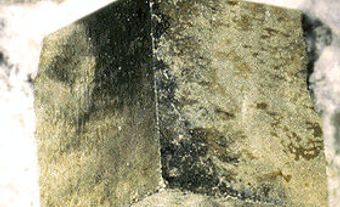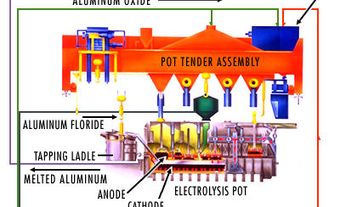Salt
Sodium chloride (NaCl), or common salt, is ubiquitous in the environment. In its solid form, salt crystallizes as colourless cubes and is called rock salt. Salt is also known to geologists as halite. Its crystal structure was the first to be determined by X-rays. Salt crystals are transparent to translucent.
In 1866, Samuel Platt drilled for oil near Goderich, Ont. Although oil eluded him, he struck a thick bed of clean white salt, the Salina formation of the Michigan Basin, which underlies much of southwestern Ontario. In western Canada, salt beds extend in a broad belt from southwestern Manitoba to northern Alberta. The Atlantic provinces are underlain by a sedimentary basin containing thick pockets of salt.
Rock Salt
Underground deposits of rock salt are recovered either by conventional room and pillar or bench mining, with subsequent milling and refining either underground or at the surface, or by the brining method, where water is injected into deposits and the resulting saturated solution is pumped to the surface. The brine is then put through vacuum triple- or quadruple-effect evaporators, where salt is recrystallized. In Canada, rock salt is extracted in Nova Scotia, New Brunswick, Québec, Ontario and Saskatchewan, where it is a byproduct of potash production. The brining technique is used in Nova Scotia, Ontario, Saskatchewan and Alberta.
Salt is an essential part of the human and animal diet, aiding in digestion, but overconsumption is widely held to be a cause of hypertension and heart disease. The production of salt is one of the oldest chemical industries. Because of its value, in ancient times salt was used as a currency. It is used as a seasoning by the food industry, in curing meats and preserving fish, and in northern countries like Canada it helps control ice and snow on roads. Growing concerns over the environment and the corrosion of infrastructure such as bridge decks and parking lots have led to numerous experiments with de-icing salt substitutes. Environmental effects of de-icing salt may include adverse impacts on plant growth and crop productivity in the immediate vicinity of highways, as well as temporary higher salinity levels in streams and groundwater systems. However, salt is still the most efficient and least expensive de-icer.
Salt in the Chemical Industry
The Chemical Industry uses salt to manufacture chlorine, caustic soda, soda ash and sodium chlorate, which are used in the production of paper, soap, fibres and petrochemicals. Canada is the world's largest per capita consumer of salt, largely because it is widely used to improve winter driving conditions. Canada is the fourth-largest world producer of salt behind the US, China and Germany. Canada produces more than 13 Mt of salt annually. Canada could easily supply the total Canadian requirement, but trade is more economical, particularly with the US, because of the expense of transporting such a high-bulk product over great distances. The US accounts for more than 99% of Canada's salt trade. However, exports are consistently higher than imports.

 Share on Facebook
Share on Facebook Share on X
Share on X Share by Email
Share by Email Share on Google Classroom
Share on Google Classroom


